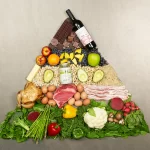Since becoming a mother almost 3 years ago I have definitely learned a thing or two about getting my daughter to eat her vegetables and, more so, about how to teach her about what healthy eating is all about. As a health coach I do have a bit of an understanding of why it is important but actually doing it – well, that is quite the different story.
I know all you mothers and fathers must have similar struggles. You want your children to be healthy and know that one sure way is to get them to eat more of the dreaded vegetables.
Just talking about adding those in can drive a person over the edge!
And of course it would! Vegetables on the plate often mean you are met with children who whine and complain about the food – constantly. It becomes a big game just trying to get them to eat a bite. It is frustrating, to say the least. But like that saying goes, that which is challenging is usually worth it. Vegetables are worth it. Collectively, they offer you just about every vitamin your body could ever need. There is nothing you will get from fruit that you couldn’t get from a vegetable.

That said, they don’t taste often as good as fruit, {even though like fruit, there is sugar in vegetables}. So they can be harder to get down.
I have learned quite a few tips and tricks to not only get my daughter to eat vegetables {when we adopted her at age 4 she hadn’t had a lick of them} but to teach her about the importance so she embraces them differently. Which I think is key. Passing on a true understanding about the why they are important and what they actually are can make them more appealing.
I remember some of the first meals and the long first year of getting my daughter to eat anything healthier than a pop tart. They were trying for sure. Aside from the knowledge I learned in school about getting anyone at any age to eat healthier, one piece of advice helped me forge on.
My dear friend and nutritionist reminded me “Nourishment is an accomplishment that will happen over months…practice patience.”
You’ll see things change over time.
Boy she wasn’t kidding! It does take time…and patience! A lot of patience. And remembering that nourishment doesn’t come from one meal alone – that it builds up and grows stronger over the course of many meals should come as a relief (as the reminder did for me). There are ample opportunities to accomplish nourishment – and they never end.
While this post isn’t to teach you how to have more patience (but you can learn more here and here about how slowing your mind and meditating helps with patience), it is about sharing with you what I did and still do with my daughter to get more veggies and healthy-living-tidbits into her life.
- Know this: It’s never too early to teach about healthy eating. I remember people telling me, “She’s too young to really ‘get’ that concept.” And I would think, well, let me give it a try. At some point she’ll get it. I might as well start now. And I am glad I did. I started right away (for me that was age 4 but I would start as early as possible if you have the chance) in telling my daughter about what certain vegetables were, what they did in the body, and why it was important. I didn’t use particularly difficult terms but rather explained processes in very lay terms. You can simply google information about the veggie you are trying to get you child to eat more and literally read it to them. The more you talk about it and teach, the more it becomes knowledge. And that will help them for the future.

- Share the plan. Let your children know that the “plan [from now on]” is to add in more vegetables and tell them why. At least this way they won’t be surprised when they actually show up on the plate more frequently. My husband and I reiterated the importance of eating vegetables a lot and let our daughter know that we’d be including them in the meal plan — something we talked about freely in front of her. When we go out to eat or when we make lunch on the weekends we now ask her “what vegetable do you want to have?” It isn’t an option as to whether she will have a vegetable, just her option on which one it will be. It’s part of our “plan”.
- Keep the vegetables on the plate. I get that the constant whining pushes you to the edge leaving you wanting to yell Uncle. You want to give up and say, “who cares if she eats brocolli!”. Don’t give up. The more you put a vegetable in front of them the more likely they are to try. (Of course that could take some considerable persuading on your part but in the end it is worth it). Remind them (even the youngest ones) what the “plan” is and why.
- Hide them. Let me quickly clarify that I am not a fan of hiding vegetables but there are ways to add them in in fun, more tasty ways. Enter the smoothy. I started introducing these just before my daughter was 5. I used water as base and added in lots of goodness: a large handful of kale, some spinach, flaxseed, hempseed, coconut oil, collagen/protein powder. And then added in some natural sweet to hide the “green” taste: lots of blueberries and strawberries, and some cinnamon made for a great tasting shake. I let my daughter see what I am putting in and continue to tell her about the benefits of all the foods in it. This way I know I am getting the good in her and changing it up a bit, too, so it becomes more fun on her end and, truthfully mine as well. {There isn’t nearly as much whining or playing around with food when it comes to drinking a tasty smoothy.}
- Dress them up and season them well! The more creative you can be with vegetables the more enticing to children. Buy baby carrots in the rainbow colors. My daughter loves the purple ones because, well duh, they are purple! They are different. Make sweet potato or zucchini chips, or kale chips; it’s a new and different take on vegetables that they will devour. Eventually they will get a feel for the taste of different vegetables without doing too much masking and then you can start to add in things like minestrone soup. Know that the more they eat a veggie that tastes “good”, the less afraid of them they will be.
- Be the example. The more your children see you eating different kinds of vegetables the more likely they are to try them. My daughter sees me eat vegetables with every meal. She watches me chop broccoli and “rice” cauliflower. She has helped me prep kale for kale chips and helped me make tossed salads. Over time her interest in these vegetables has grown and now she picks at them and eats them more easily when they are presented to her than she did before.
- Take them to the grocery store. I have to honest and tell you that I fought this for a while. I had no desire to bring my daughter to the store. I have my list, my routine in the store and I want to go in…and get out. Fast. A child, well you know…they can mess with that plan easily! But I have learned how beneficial it is now, especially since she is interested more in the food we are eating. She not only sees me picking out the vegetables but it is a perfect classroom to teach her about all kinds of other foods.
- Grow a garden. Even a small garden with a few choice vegetables entices children to want to eat them. And if they have a green thumb like my daughter, they will be willing to help you pick and wash your produce. This saves you money at the grocery store and teaches a valuable lesson to your children about how real food comes to be. Letting them see real food for themselves allows them to see the discrepancies with other kinds of food. Teaching them what is real, now, will help them in making healthy choices in the future.
The more you do this the more it becomes habit.
And physically, the body responds in kind. Taste buds change every 10 days. And we are naturally inclined to like the taste of sweet over anything else. If your children are very young (infant), I’d recommend you start now to give them those greens (blended up of course) with a touch of apple or sweet potato. It preps their buds and can make vegetables in general more favorable. If your children are a bit older, any amount you can get in them to help their taste buds get that hankering for veggies helps.
Eating real, vitamin-rich and nutritious food is essential for all of us. It is what gives us the energy to do the day – well.
In my opinion, teaching your children about why it is important and as much about vegetables as possible will help them to grow up to make healthy, smart decisions with food.
Once you make vegetables a mainstay they do become something to be enjoyed…almost craved. Our daughter, who cried and cried about eating vegetables, now asks for seconds and thirds of broccoli. I know! It is crazy and I wouldn’t believe it if I didn’t see it. It happened over time.
And with patience and diligence, you’ll see things change over time as well.
And your children {and you!} will reap the many benefits of your efforts.
What is your biggest challenge in getting your children to eat vegetables? Let’s talk about it in the comments!
-
[…] little tip: whether your child is in the habit of eating a vegetable at lunch or not, the more you put a food in front of a child the more likely they are to eat it. It’s how I got my daughter to find a love for some […]





So important this piece on vegetables. I get it!